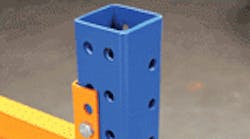As we report in MH&L’s June issue, lift trucks have come a long way in what they enable material handlers to accomplish. Companies can now move heavier loads farther and higher on a single shift than ever before. But, as with most great achievements, you have to be ready for unintended consequences. Lifting heavier loads higher changes stability factors and lift truck operators must keep those in mind.
Lift truck manufacturers have come up with ways to keep operators from making potentially dangerous maneuvers under certain loads. But even this English major knows Newton’s contribution to the laws of physics: “For every action there is an equal and opposite reaction.” That has a corollary in philosophy: Everything you do in life has consequences.”
So, while making lift trucks more stable under heavier loads is great, the same must be done for any structure receiving heavier loads. This point is made abundantly clear in a white paper we just posted to our site on the use of tubular racking in buildings. The paper focuses specifically on the effects of seismic activity on these structures.
What got me so philosophical while reading this paper was the realization of how far material handling systems have come in moving more stuff faster and faster. This paragraph about the impact of “big box” stores like Home Depot and Costco as they employ newer and bigger technologies for manufacturing and shipping makes a particularly important point:
“These facilities currently use tall metal storage racks to hold standard forklift-ready pallets loaded with objects typically weighing thousands of pounds, i.e.: vehicle engines, heavy machinery, appliances. With the advent of large forklifts capable of raising pallets 24 feet and higher, the racks are vulnerable to swaying, collapsing or toppling during an earthquake—a scenario for disaster.”
As shippers try to build denser truckloads to lower transportation costs, pallet loads are likely to get heavier too—as much as 3500 pounds, this paper predicts. It also notes that the Federal Emergency Management Agency (FEMA), acting under the National Earthquake Hazards Reduction Program (NEHRP), issued a 160-page report specifying recommendations for improvements to buildings and their contents, including steel pallet storage racks located in areas accessible to the public and to employees.
This report serves as the basis for establishing seismic requirements for building codes and standards.One of its recommendations is to avoid confusing building design with rack design. It notes that the rigid behavior of rack structural system members and connections are “significantly different from those of building structural systems,” and that “storage racks do not have the added benefit of diaphragms or secondary structural elements found in building structures.”
The white paper addresses the nonlinear behavior of old-style racks and the necessary detailing that will ensure a rack’s seismic response will be acceptable.
This is a good read for all material handlers going “bigger and better”—even those who aren’t sitting on top of a fault line. It’ll remind you to consider the changes Mother Nature may make once you’ve made yours.



